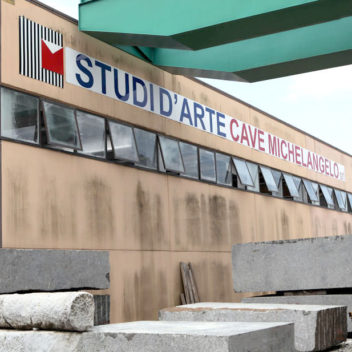
Studi D’Arte Cave Michelangelo
Studi D’Arte Cave Michelangelo is a facility of vital importance to the formation of young sculptors. Founded by the Cave Michelangelo Group as part of its enduring effort to have the city of Carrara continually recognized as a historical center for marble extraction and sculpture, it gives these artists a chance to work alongside first-rate, expert teachers in an environment of unparalleled cultural osmosis. The Workshop consists of a facility for art production in which the development of sculptural techniques and the availability of space and materials combine to allow the “bottega d’arte” tradition to continue and thrive in a contemporary setting. This is a truly important enterprise which maintains and hands down knowledge of traditional methods of sculpture which would otherwise risk being forgotten.
The Studi D’Arte Cave Michelangelo project came into being thanks to an investment made in recuperating and transforming a 2500 square meter industrial plot, part of which is set aside for the cutting of blocks and slabs, and the rest of which has been rendered a workshop for modern sculpture. The Workshop, which is well equipped for all kinds of sculptural dimension work, is particularly suited to carrying out large, monumental works.
The Polvaccio quarry used by the Group dates back to the 1st century BCE and the era of the Roman Republic. In those days, marble was transported from the port of the city of Luna (known today as Luni) to destinations throughout the Mediterranean. Polvaccio is one of the most famous quarries in Luni for the quality of the marble extracted from it: Pliny the Elder refers to the area and describes the marble as being purer and whiter than the Paro marble of the Greeks. Marble from Polvaccio was used for works like Trajan’s Column, the Arches of Titus and Septimius Severus, and the statue of Apollo Palatinus. It was also in this quarry that Michelangelo chose his marble and worked directly on the blocks for such major works as the Tomb of Julius II and the Pietà. In recent years, new levels of excavation have been opened up in the top part of the basin, which will guarantee the continued production of marble statuary and top grade white marble.